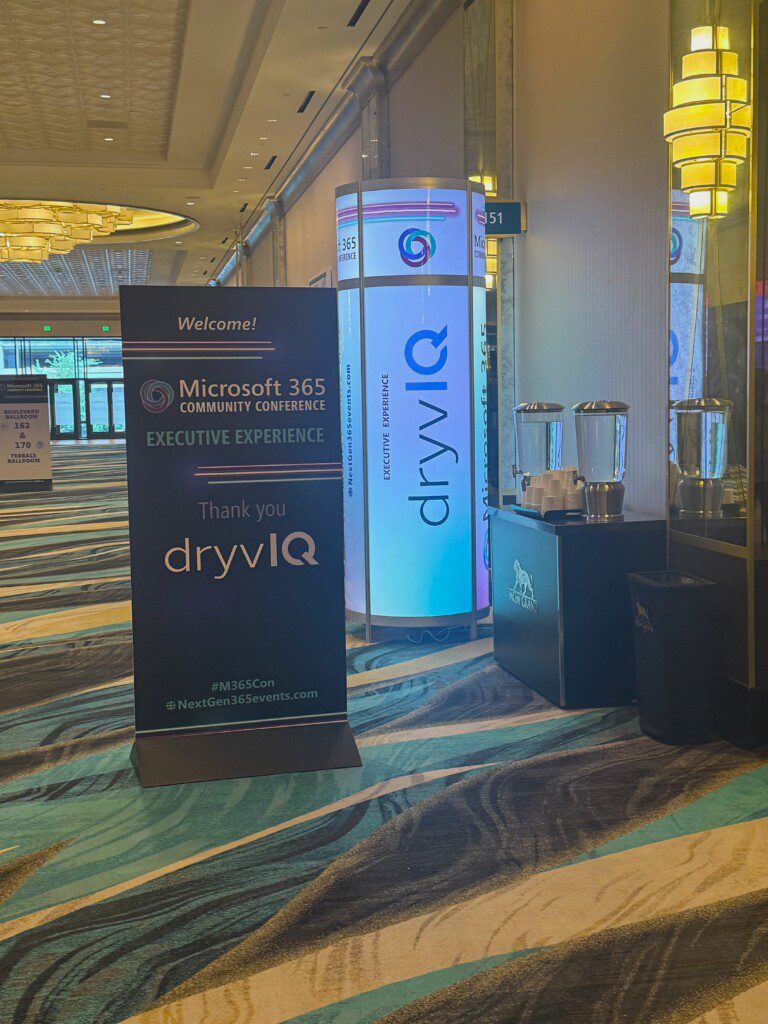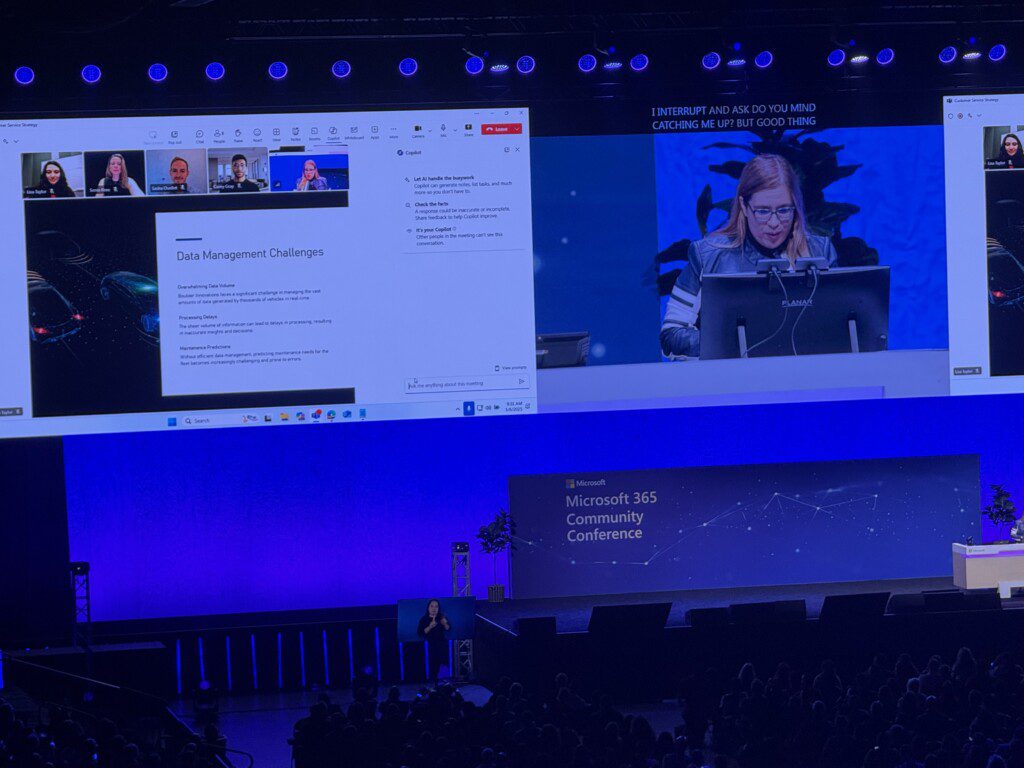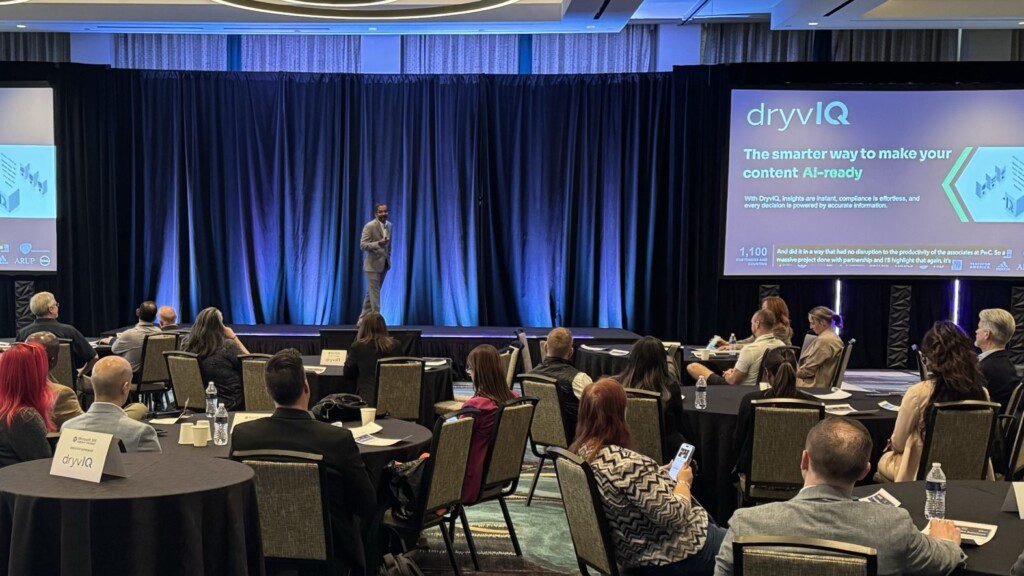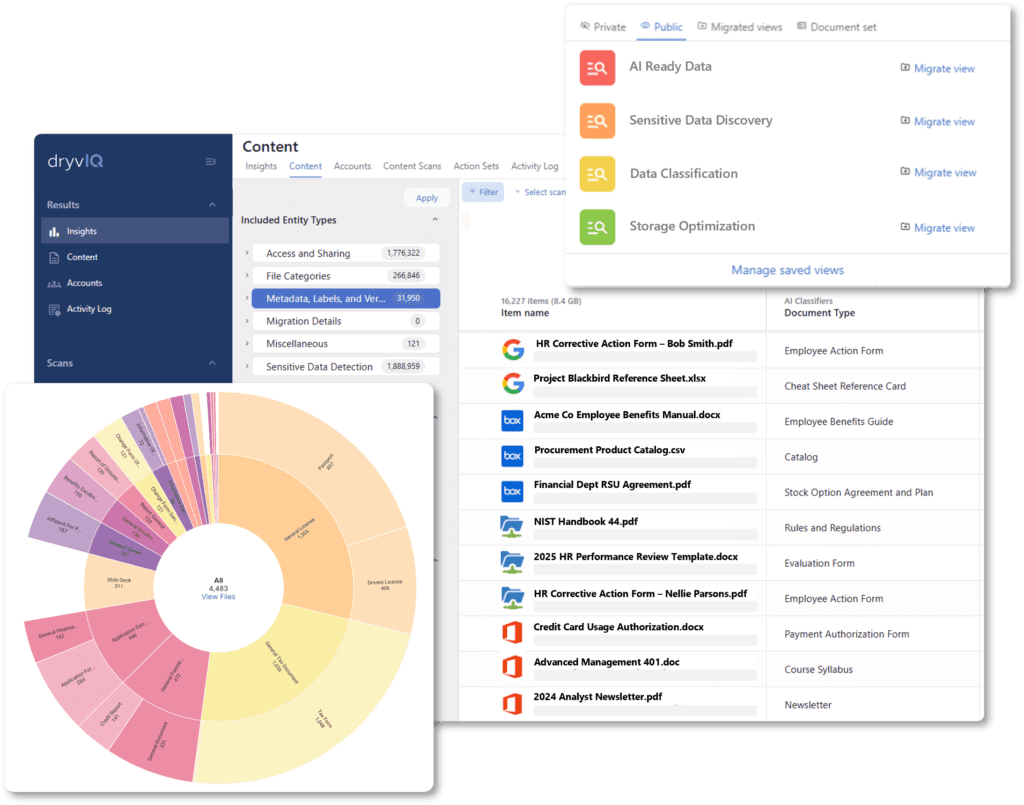DryvIQ
• May 28, 2025Earlier this month, the DryvIQ team landed in Las Vegas for the M365 Community Conference—an invigorating gathering of industry leaders, Microsoft experts, and IT pros from some of the world’s largest enterprises. As a proud exclusive sponsor of the Executive Experience portion of the event, we immersed ourselves in conversations about the evolving role of AI in enterprise collaboration and productivity.
The buzz was undeniable: AI is no longer in the experimentation phase—it’s being embedded into core business processes at scale, and Microsoft is leading the charge in enabling the human-led, AI-powered future. Here are some insights, takeaways, and key challenges that stood out most to our team on the ground at M365Con.

Top 3 Themes that Dominated the M365 Community Conference
1. Copilot Everything… from M365, to Studio, and Agents
AI wasn’t just a topic at this year’s M365 Community Conference—it was the topic. From M365 Copilot to Copilot Studio and Copilot Agents, Microsoft’s rapidly expanding suite of AI-powered tools took center stage. Nearly half of the 200+ keynotes and sessions focused on Copilot, agents, and the broader vision for AI in the workplace, underscoring just how central this technology has become to Microsoft’s roadmap and its customers’ strategies.
M365 Copilot
Attendees were eager to learn how their peers and industry experts are putting M365 Copilot into action, whether that meant accelerating adoption, fine-tuning existing use cases, or unlocking new ones. Sessions were packed with real-world examples and practical guidance for getting the most out of Copilot’s capabilities. One of the most exciting topics covered Microsoft’s recent launch of the Copilot Researcher and Analyst agents, which give users new ways to automate insights gathering and data analysis directly within the tool they use every day, like Word and Excel.
Copilot Studio
Copilot Studio is opening doors for teams far beyond IT. Many sessions explored how to empower business users to build their own AI-driven workflows, without needing to write code or rely on developers. The hype surrounding Copilot Studio is less about technology itself, but about the shift it enables: giving more people across the organization the ability to streamline processes, connect to backend systems, and solve real business challenges with automation. For many, Copilot Studio represents a practical way to scale AI without scaling complexity.
Copilot Agents
Copilot Agents were another major focus of discussion, particularly when it came to Microsoft’s vision of human-led, AI-powered workplaces, dubbed “Frontier Firms.” Copilot Agents are AI teammates designed to take real action—autonomously managing tasks, workflows, and business processes across your apps and data. In the AI-driven future, there is an agent ready to be put to work for every role and every scenario, within every application.

2. Security in the AI Era Requires Extra Vigilance
In a standout keynote, Vasu Jakkal, Microsoft’s Corporate Vice President of Security, painted a sobering picture of today’s threat landscape and the importance of data security in the AI era. Consider these stats:
- The average time for a phishing attack to uncover sensitive data is just 1 hour, 12 minutes.
- In 2024, there were 7,000 password attacks per second, up significantly from 2023 (4,000 per second).
- 83% of organizations experience multiple breaches over their lifetime.
- Insider threats cost organizations an average of $15.4M annually.
And, notably, 80% of leaders cited sensitive data leakage as a top concern for AI adoption.
As AI systems become more powerful, their potential attack surface grows. Enterprises must evolve their data protection strategies by identifying and classifying dark data, tightening user access controls, and ensuring AI tools aren’t exposed to sensitive or non-public data.

3. Orgs are Eager to Deploy AI —But Facing Real Challenges
There’s no question that organizations are excited to bring Microsoft’s AI solutions to life, but that energy is often met with complexity. In conversations throughout the event, four common themes emerged around what’s holding teams back:
Executive Alignment Isn’t Optional
Nearly every successful AI story we heard shared one thing in common: strong, top-down sponsorship. Without clear executive commitment, AI initiatives stall. Leaders need to be visibly engaged, not just approving projects but actively championing them and modeling adoption.
Focused Use Cases Drive Real Progress
We heard from many teams that initially tried to go broad, deploying AI across multiple departments and applications at once. But that approach quickly led to diluted impact and unclear success metrics. Organizations making the most progress are defining high-impact use cases, aligning on success criteria, and proving value before scaling.
This Isn’t Just Tech Adoption, It’s Behavior Change
AI implementation isn’t a traditional technology rollout. It requires a shift in how work gets done. Employees need to rethink their workflows, decision-making processes, and even collaboration strategies. That kind of change only works when leaders go first, setting expectations, removing friction, and creating space for experimentation.
Downstream Blockers – Like Data Readiness – Can Derail Momentum
Even with alignment and focus, AI initiatives can falter if foundational issues aren’t addressed early. Data readiness, security governance, and change management planning all came up repeatedly as areas where delays happen. The message was clear: get ahead of these hurdles before you hit them.

From Shared Struggles to Strategic Solutions
Everyone’s feeling the pressure to “do AI,” and to do it fast. But the path forward does not mean AI everywhere, all at once. It starts with a few pragmatic shifts: focused use cases, aligned leadership, and AI-ready data. Here are some actionable steps to take before full-scale deployment of AI:
1. Zero in on High-Impact Use Cases
Start small and strategic. The most successful teams are identifying use cases that solve real problems, deliver measurable value, and create momentum for broader adoption.
2. Get Executive Alignment Early
Top-down support isn’t optional—it’s essential. Leaders need to champion the effort, model new ways of working, and help clear the path for change. Starting with those high-impact applications makes it easier to build the business case for AI and get executives on board.
3. Build a Realistic Roadmap
A thoughtful plan goes a long way. That includes assessing your current ecosystem, consolidating platforms where it makes sense, and factoring in other line-of-business applications like Salesforce, Docusign, or legacy ECMs that intersect with your content and workflows.
4. Understand What Data You’re Working With
You can’t move forward without visibility. Start by inventorying your unstructured data repositories to see what content you have, how it’s being used, and where the biggest risks and opportunities lie.
5. Get Your Data in Shape for AI
Use those insights to take action:
- Classify and enrich content to add structure, context, and purpose—beyond just basic metadata
- Curate use-case-specific datasets so AI tools access only what they need
- Scan and cleanse dark data to uncover what’s valuable and eliminate what’s not
- Anonymize sensitive information to unlock insights without compromising privacy
- Audit access and permissions before rolling out AI tools, and establish continuous monitoring moving forward
Not sure where you’re at on your data readiness journey? Check out our AI-Ready Data Checklist for a practical guide to preparing your content for secure, effective AI use.
Don’t Just Guess at Where to Start – Let Your Data Guide You
When it comes to prioritizing where to start with AI, your data holds the answers. A focused proof of concept (POC) can uncover which use cases offer the most impact—and which areas of your business are truly ready for AI.
Running a POC with an intelligent data management platform, targeted at a specific department, repository, or business unit, can quickly help you:
- Visualize what types of data you have, along with age and usage patterns
- Identify where sensitive or stale data lives, and who has access to it
- Prioritize which areas need organization, clean-up, or enhanced governance first
A small-scale POC gives you a preview of the whole picture, helping your team build a clear, actionable roadmap for enterprise-wide AI readiness.
Quick Start Option:
DryvIQ is now available in the Microsoft Azure Marketplace. This makes it easier than ever to start analyzing and classifying your unstructured content, without a full-scale deployment across your entire enterprise. Get instant insights, assess your AI readiness, and chart your next steps with confidence, starting at $2,500.

Looking Ahead
One of the most thought-provoking moments of the M365 Community Conference came from an executive panel, where a speaker summarized AI’s impact this way:
“The internet democratized information. AI will democratize intelligence.”
It’s a powerful framing—and one we saw echoed throughout the event. Whether improving customer experience, securing digital assets, streamlining supply chains, or accelerating R&D, AI is no longer an emerging trend. It’s here to stay. It’s ready to scale. And it’s changing the way we do business.
Whether your goal is to unlock new revenue streams, reduce risk, support AI adoption, improve compliance, or drive efficiency, DryvIQ ensures your unstructured data is always ready for what’s next. Speak with one of our unstructured data experts today to get started.
Related Posts
Discover what DryvIQ can do for your business
Let’s build the foundation for smarter decisions,
stronger security, and AI-powered outcomes.
Talk to an expert

Ready to see DryvIQ in action?
Stop drowning in data chaos. Start driving business outcomes.
Book a demo
